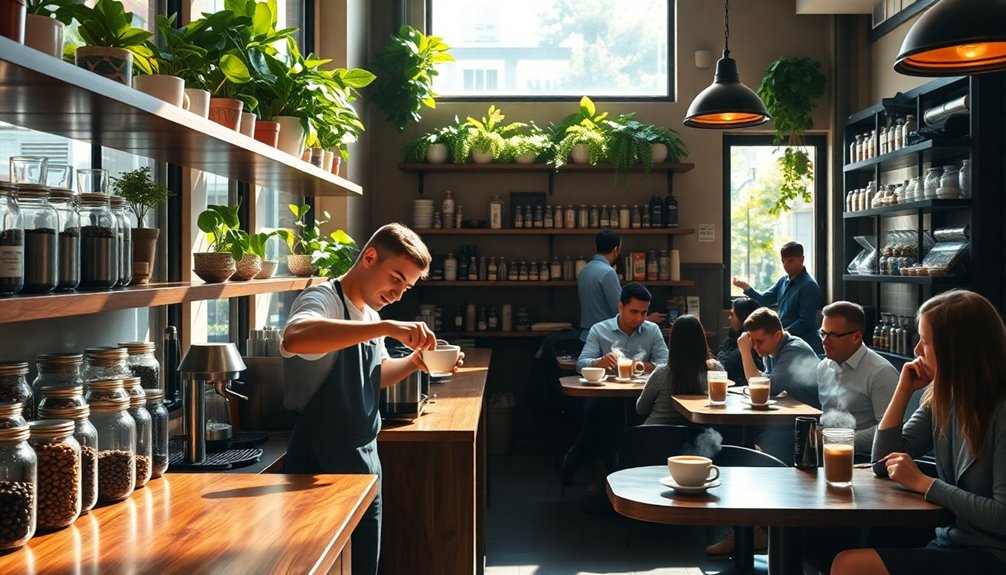World War II was a game changer for coffee history. It led to rationing, with strict measures in place that reshaped how you consumed coffee daily. You had to adjust to limited access and turn to substitutes like chicory. The military's demand for coffee, which boosted soldiers' morale, prioritized supply despite civilian shortages. After the war, coffee culture blossomed, paving the way for modern coffee experiences. Discover how these shifts continue to influence coffee today.
Key Takeaways
- World War II necessitated coffee rationing in the U.S. due to shipping disruptions and military prioritization of wartime supplies.
- The Office of Price Administration regulated coffee prices and distribution, impacting civilian access and consumption habits.
- Coffee rationing altered daily routines, leading to the rise of substitutes like chicory and the emergence of black markets.
- Military dependency on coffee for troop morale ensured consistent supply despite civilian rationing, with instant coffee becoming a staple.
- Post-war recovery revitalized coffee culture, resulting in increased imports, bustling coffeehouses, and advancements in brewing technology.
The Rationing Period and Its Causes
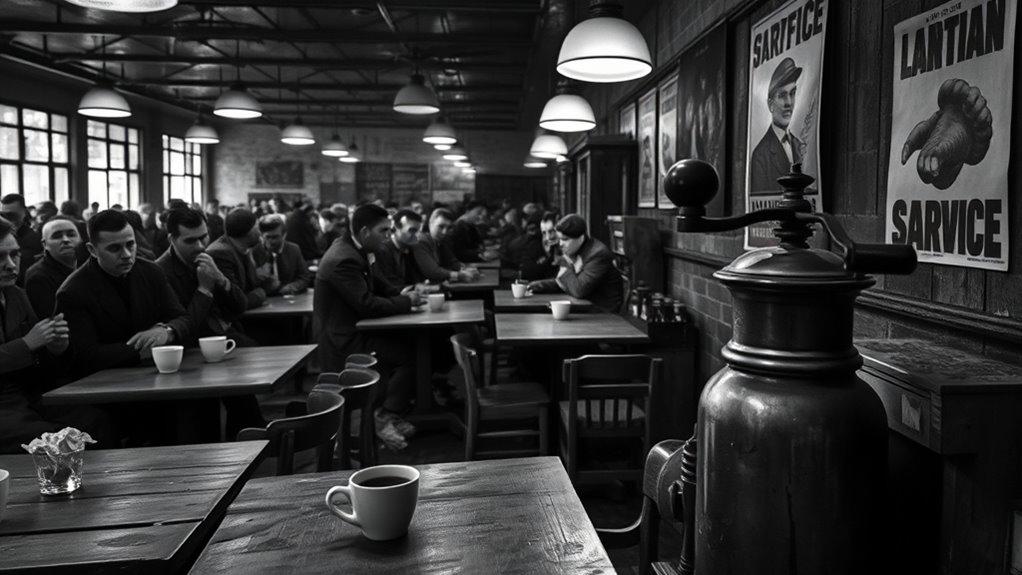
As World War II intensified, rationing became a necessary measure in the United States, largely due to shipping disruptions caused by German U-boats. These disruptions severely impacted coffee imports, forcing the military to prioritize shipping space for supplies.
You mightn't realize that despite record production in Latin America, resource allocation favored wartime needs over civilian coffee access. The Office of Price Administration stepped in, regulating prices to control inflation and ensure fair distribution among citizens. During this time, many families also turned to substitutes like chicory as a way to cope with the diminishing availability of coffee. Mindful consumption became essential as families adjusted their lifestyles to adapt to the scarcity of resources.
As coffee became scarce, black market activities emerged, complicating the situation. Adjusting to these changes, you likely turned to substitutes like chicory, while grappling with the broader implications of rationing that affected your daily life and reflected the war's impact on American culture. Interestingly, during this period, many households also experimented with butter as a substitute in baking and cooking due to the scarcity of other ingredients.
Implementation of Coffee Rationing

When coffee rationing began on November 29, 1942, you might've felt the immediate impact on your morning routine.
Initially, you received just one pound of coffee every five weeks, but by February 3, 1943, that dropped to one pound every six weeks.
Coffee rations dwindled from one pound every five weeks to just one pound every six weeks by early 1943.
The Office of Price Administration (OPA) managed this rationing, using War Ration Book stamps—specifically stamps #19-28.
Only family members over the age of fifteen could redeem these stamps. Additionally, the implementation of rationing was partly influenced by the need for economic benefits as resources were redirected to support the war effort.
To prevent hoarding, sales halted before rationing started, and retailers had to keep detailed records of coffee sales.
Shipping disruptions caused by German U-boats complicated supply, while military priorities further strained resources, making your beloved morning brew a precious commodity during this challenging time. Additionally, the rationing system was designed to ensure cooperative planning among consumers and producers to adapt to the wartime economy.
Effects on Daily Life and Consumption
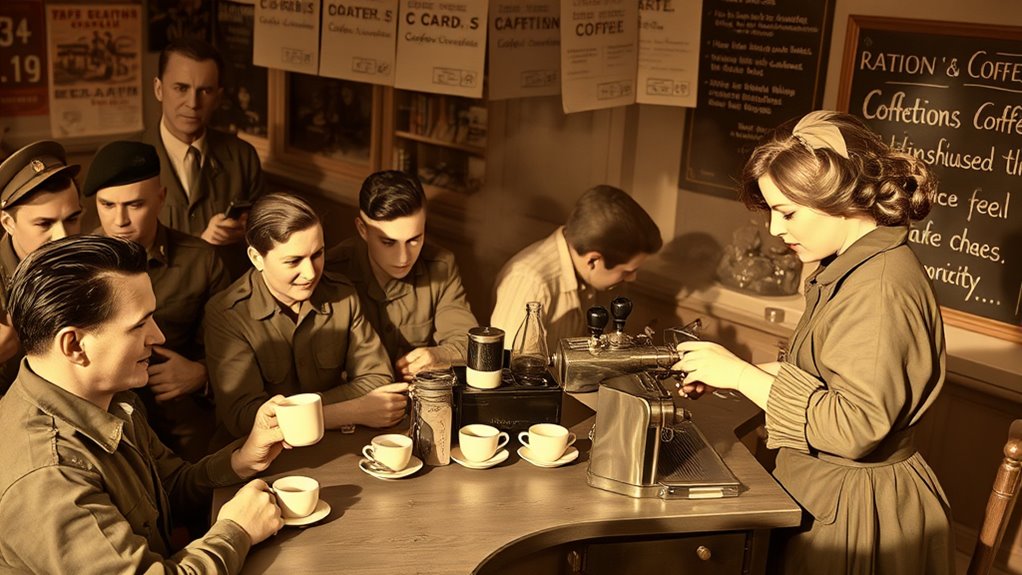
The impact of coffee rationing during World War II reshaped daily life in profound ways. With global shortages and rising prices, you felt the pinch in your morning routine.
Governments imposed rationing policies to ensure fair distribution, which sparked black markets for coffee, complicating access. As a result, you might've turned to substitutes like chicory or local alternatives, adapting culturally to the scarcity. Chia seeds, known for their high fiber content, became a popular addition to meals as people sought nutritious options during this challenging time. Many also began to explore no-sugar-added brands as a healthier hydration choice amidst the limited availability of coffee.
Coffee became a symbol of community, fostering bonds among friends and family while serving as a patriotic duty. Your daily interactions and work performance shifted as you adjusted to reduced coffee consumption, feeling the effects of these changes on both personal and social levels. Coffee enhances athletic performance during this time, as many sought energy boosts to cope with the demands of wartime life.
Coffee, once a simple pleasure, transformed into a complex part of wartime life.
The Military's Dependency on Coffee
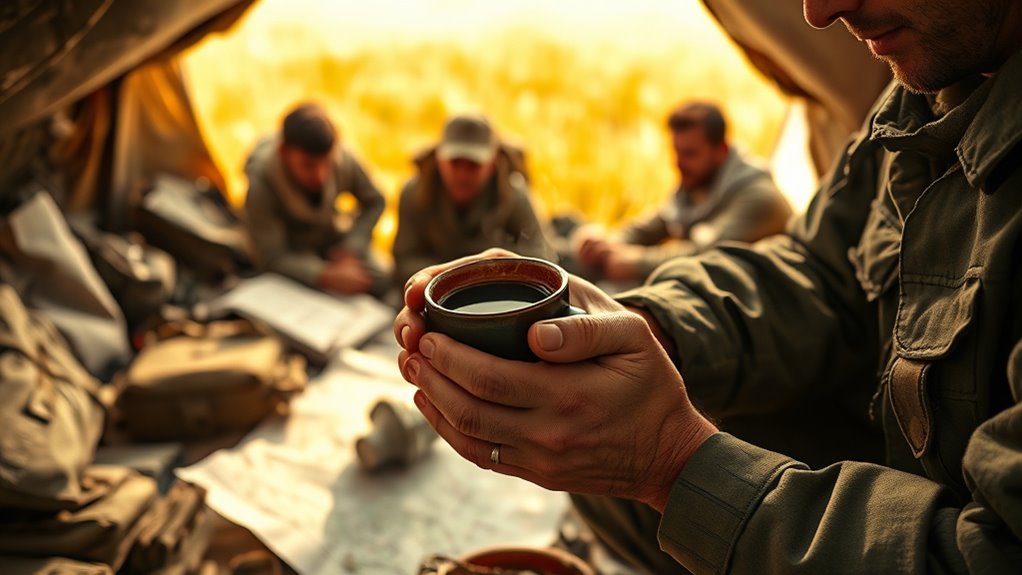
Coffee's significance extended beyond the home front, shaping military life in World War II. Troops relied on coffee for a morale boost, especially during stressful combat situations. The importance of color accuracy in maintaining focus during long missions was echoed in the soldiers' reliance on caffeine to stay alert. Additionally, a clean and organized environment, even in makeshift camps, helped improve soldiers' mental well-being, enabling them to better cope with the stresses of war.
As military coffee consumption skyrocketed after the U.S. entered the war, the military prioritized its supply, ensuring soldiers had access despite rationing at home. Instant coffee became a staple in military rations, packaged in lightweight envelopes for convenience. You'd find it included in Meals, Ready-to-Eat (MREs), paired with sugar and creamer. The caffeine kept you alert and focused, vital in combat scenarios.
Although coffee supply chains faced challenges, innovative solutions helped maintain a steady supply, reinforcing coffee's crucial role in supporting military personnel throughout the war. Air purifiers also played a role in enhancing soldiers' well-being by improving the quality of air in makeshift camps.
Post-War Developments and Lasting Impact
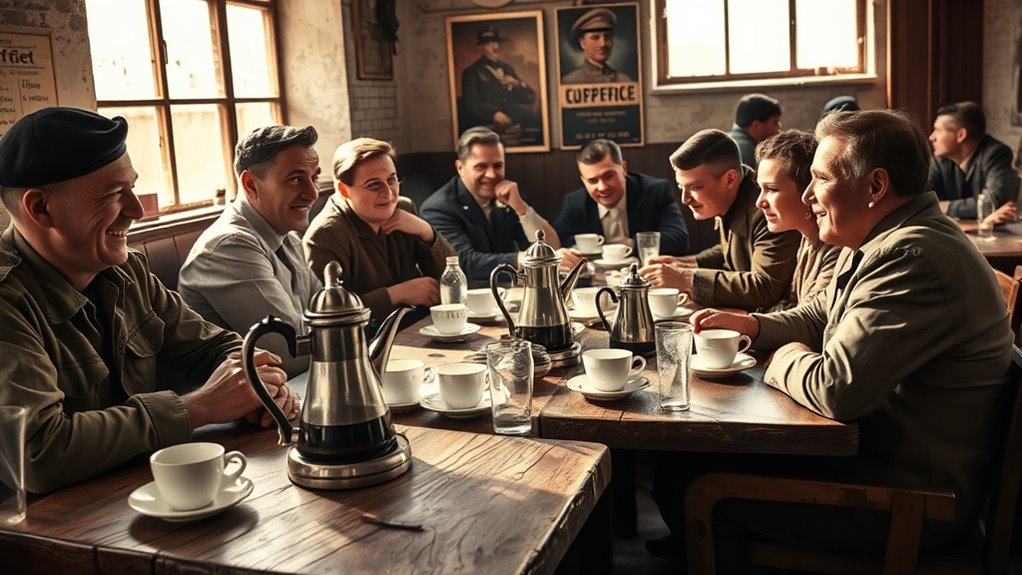
As World War II came to an end, the coffee landscape transformed dramatically, reshaping how people consumed and appreciated this beloved beverage. Increased imports and a recovering industry brought coffee back to pre-war levels, opening new markets, especially in Europe. Prices stabilized, allowing you to enjoy coffee as a luxury rather than a rationed necessity. The revival of coffee culture led to bustling coffeehouses and diverse products like instant coffee and Fried Egg Quesadilla Toast specialty blends. Technological advancements improved processing and brewing methods, enhancing your experience. For instance, the development of bottled lemon juice provided convenience in beverage preparation, which paralleled innovations in the coffee industry. However, this growth also raised environmental concerns about packaging waste, prompting early sustainability efforts within the industry. Furthermore, the use of necessary cookies on coffee-related websites improved user engagement and personalization in the coffee shopping experience.
Frequently Asked Questions
How Did Coffee Rationing Affect International Coffee Trade?
Coffee rationing severely impacted international coffee trade by reducing U.S. imports due to shipping disruptions and military priorities.
You'd notice that global shortages arose, affecting not just Americans but also Europeans.
As rationing took hold, black markets emerged as people sought ways to bypass restrictions.
With less coffee available, consumption dropped significantly, and substitutes became common.
Ultimately, these changes reshaped trade dynamics and consumer habits in profound ways during that period.
What Were Popular Coffee Substitutes During the Rationing Period?
During the rationing period, you'd find popular coffee substitutes like chicory root, roasted grains, and even burnt rice.
Chicory mimicked coffee's flavor and was caffeine-free, while roasted barley and wheat provided hearty alternatives.
You might've also come across Postum, a blend of roasted grains and molasses.
Many people got creative with these substitutes, adjusting their coffee habits to cope with shortages and still enjoy a warm beverage despite the challenges.
How Did Coffee Rationing Impact Coffee Production Techniques?
Imagine a world where your morning cup of coffee is a distant dream! Coffee rationing forced producers to rethink everything.
You'd see roasters limited to a fraction of their usual supply, leading to creative brewing techniques that maximized every precious bean. Packaging changed from cans to jars due to shortages, and innovative methods like "double dripping" became essential.
These adaptations shaped not just how coffee was made but also how you enjoyed it daily!
Were There Any Notable Protests Against Coffee Rationing?
There weren't any notable protests against coffee rationing during that time. Most people understood the necessity behind it, even if they didn't like it.
While some grumbled about the situation, they generally accepted it as part of their patriotic duty. Instead of widespread demonstrations, many turned to creative coping methods, like using coffee substitutes or stretching their supplies.
The sense of sacrifice for the greater good kept protests largely absent from the scene.
How Did Coffee Rationing Influence Post-War Coffee Marketing Strategies?
After coffee rationing ended, demand skyrocketed, with consumption jumping by 50% in the post-war years.
This surge influenced marketing strategies significantly. You'll notice ads highlighting quality and authenticity, distinguishing real coffee from wartime substitutes.
Instant coffee gained popularity, showcasing convenience. Marketers emphasized community and comfort, reminding people of shared experiences over a cup.
Conclusion
In the grand tapestry of history, World War II wove coffee into its fabric, transforming it from a simple beverage into a symbol of endurance. Rationing reshaped your daily rituals, while the military's reliance on coffee fueled both soldiers and morale. As the war ended, the echoes of these changes lingered, forever altering your relationship with this beloved drink. Coffee became not just a source of energy, but a testament to resilience, binding people together through shared experiences.



